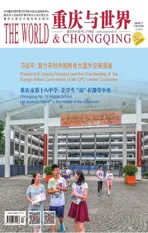见证中国人民不屈的抗战精神聚焦重庆建川博物馆聚落群(上)
2018-08-01唐安冰
□ 文 图/本刊记者 唐安冰
□ Article&Photo/ Journalist Tang Anbing Translator/Chen Xiushi

重庆建川博物馆位于九龙坡区鹅公岩公园内,是利用抗战时期兵工生产洞洞体作为馆址设立的博物馆聚落群,由兵工署第一工厂旧址博物馆、抗战文物博物馆、兵器发展史博物馆、票证生活博物馆、中医药文化博物馆、重庆故事博物馆、中国囍文化博物馆和民间祈福文化博物馆等8个主题博物馆构成。展陈包括60件国家一级文物在内的各类文物藏品上万件,主要包括抗战、兵工、民俗、红色年代等近现代史料、物品。
“为了和平,收藏战争;为了未来,收藏教训……”重庆建川博物馆游客中心墙上,博物馆馆长樊建川的《馆主自白》引人注目。博物馆通过文物、版面、场景复原、多媒体展示等形式,真实反映第一兵工厂的历史风貌和中国民族兵工产业发展的艰难历程,揭示中华民族不屈的抗日精神,警示中华民族以史为鉴,努力开创和平友好的未来。
本期请跟随摄影记者镜头走进兵工署第一工厂旧址博物馆、抗战文物博物馆、兵器发展史博物馆3个场馆一探究竟。
兵工署第一工厂旧址博物馆
抗战时期,搬迁、归并到重庆的兵工厂有14家之多,第一兵工厂便是其中一家。其历史可以追溯到清末时期,前身为张之洞主持修建的汉阳兵工厂。兵工署第一工厂旧址博物馆所在地,即为第一兵工厂在抗战时期搬迁到重庆后的旧址。
第一兵工厂的生产洞,被誉为“世界第一地下兵工遗址”。在兵工署第一工厂旧址博物馆内,400余幅珍贵的历史照片、逼真的场景复原、精美的国画等,生动地反映出第一兵工厂员工躲避日军空袭、在生产洞内生产兵器的感人场景。
抗战文物博物馆
抗战文物博物馆中,写有“国难临头 共起奋斗”的搪瓷盆、绣有“抗战胜利 革命成功”的刺绣荷包、刻有“抗战必胜 建国必成”的眼镜盒……一件件珍贵文物反映了中华儿女的不屈意志。博物馆珍藏的数十件国家一级文物,几乎全部展示在抗战文物博物馆中。
步入这个博物馆,会被墙上数百枚整齐分布的老兵手印震撼。“他们的手曾经握得起命运,如今却无法握住时光。”樊建川介绍,建川博物馆从2005年开始征集抗战老兵的手印,至今已收集到6000余枚,选取部分手印在抗战老兵手印墙上展示,是为了警示后代,以史为鉴。
兵器发展史博物馆
通过种类繁多的兵器文物、图片还原了兵器从粗糙、笨重、功能单一向精致、迅捷、功能强大转变的历史全貌,全方位地展示了人类文明与科技及世界军事的发展进程。

建川博物馆建在立交桥下的一片防空洞内。
Located in the Egongyan Park in Jiulongpo District, the Chongqing Jianchuan Museum is a museum cluster using the caves for production of ordnance during the Anti-Japanese War as the site of the museum. It is consisted of 8 themed museums including Museum of First Arsenal Site of the Bureau of Ordnance, Museum of Anti-Japanese War Cultural Relics, Museum of History of Weapons Development, Museum of Life with Tickets and Coupons, Museum of TCM Culture,Museum of Chongqing Stories, Museum of China’s Xi (Double Happiness) Culture, and Museum of Folk Praying Culture. It is the home to tens of thousands of cultural relics including 60 firstclass state-level cultural relics, mainly covering contemporary historical materials and objects of the anti-Japanese war, military work, folk custom,and red era.
“For peace, we collect wars; for the future,we collect lessons...” On the wall of the Visitors Center of the Chongqing Jianchuan Museum,the Confession of the Director, written by Fan Jianchuan, the director of the museum, attracts people’s attention. Through the use of cultural relics, layouts, scene restoration, and multimedia displays, the museum truly reflects the historic landscape of the first ordnance factory and the difficult development of the Chinese national military industry, reveals the Chinese national unyielding anti-Japanese spirit, sounds the alarm to the Chinese nation of taking history as a mirror and strives to create the future with peace and friendliness.
In this issue, please follow the cameramen,and take a glimpse through the lens into three museums, namely, the Museum of First Arsenal Site of the Bureau of Ordnance, the Museum of Anti-Japanese War Cultural Relics, and the Museum of History of Weapons Development

① 建川博物馆室外兵器陈列品。

② 建川博物馆室外兵器陈列品。

兵工署第一工厂旧址博物馆外景。

介绍兵工署第一工厂内迁历史。
The Museum of First Arsenal Site of the Bureau of Ordnance
During the War of Resistance Against Japan,there were 14 arsenals relocated or incorporated into Chongqing. The First Arsenal was one of them.It can be traced back to the late Qing Dynasty,which was formerly known as the Hanyang Arsenal, built and designed by Zhang Zhidong.The Museum of First Arsenal Site of the Bureau of Ordnance is just located on the site of the First Arsenal after its relocation to Chongqing during the Anti-Japanese War.
The production caves of the first arsenal is known as “the world’s No.1 underground arsenal site”. More than 400 precious historical photographs, realistic scene restorations, and exquisite Chinese paintings in the Museum of the First Arsenal Site of the Bureau of Ordnance vividly reflect the touching scenes of the first arsenal’s employees evading from Japanese air raids and producing weapons inside the production caves. .

① 雕塑再现生产场景。

② 兵工署第一工厂发展历史。

③ 观众驻足参观。

抗战文物博物馆手印墙。
The Museum of Anti-Japanese War Cultural Relics
In the Museum of Anti-Japanese War Cultural Relics, there are enamel pots written with “Common Struggle for National Disasters”, embroidered pouches stitched with “Victory of the Anti-Japanese War Victory and Success of Revolution” and spectacle cases engraved with “The War of Resistance Against the Victory Will Come to Success and the Country Will Finally Be Founded”. Each piece of precious cultural relics reflects the indomitable will of the Chinese people. Dozens of first-class statelevel cultural relics collected by the museum are almost all displayed in the Museum of Anti-Japanese War Cultural Relics.
Stepping into this museum, one will be overwhelmed by hundreds of veterans’handprints nicely arranged on the wall.“Their hands were able to hold the fate,but now they can’t hold the time.” Fan Jianchuan introduced that the Jianchuan Museum has begun collecting handprints of veterans of the war since 2005. More than 6,000 pieces have been collected so far, and some handprints have been printed on the walls in order to alert the future generations that they should take history as a mirror.

④ 记录重庆抗战史。

⑤ 再现《新华日报》宣传抗日。

⑥ 不忘历史。

⑦ 兵器发展史博物馆。

⑧ 不同时期的兵器。

⑨ 兵器发展展示。
The Museum of History of Weapons Development
Through a variety of cultural relics of weapons as well as pictures,we have restored the historical picture of rough, bulky, singlepurpose weapons transforming into the exquisite, rapid, and powerful ones, demonstrating in an allround way the development of human civilization and science and technology as well as the world’s military.

⑩当代兵器。

[11]当代兵器。
